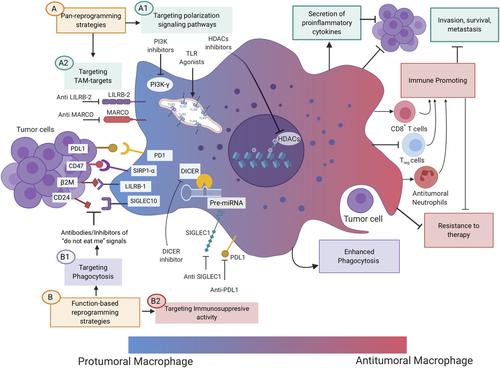当前位置:
X-MOL 学术
›
Ann. N. Y. Acad. Sci.
›
论文详情
Our official English website, www.x-mol.net, welcomes your
feedback! (Note: you will need to create a separate account there.)
Macrophage targeting in cancer
Annals of the New York Academy of Sciences ( IF 4.1 ) Pub Date : 2020-05-22 , DOI: 10.1111/nyas.14377 Martha Lopez-Yrigoyen 1 , Luca Cassetta 1 , Jeffrey W Pollard 1
Annals of the New York Academy of Sciences ( IF 4.1 ) Pub Date : 2020-05-22 , DOI: 10.1111/nyas.14377 Martha Lopez-Yrigoyen 1 , Luca Cassetta 1 , Jeffrey W Pollard 1
Affiliation

|
Tumorigenesis is not only determined by the intrinsic properties of cancer cells but also by their interactions with components of the tumor microenvironment (TME). Tumor-associated macrophages (TAMs) are among the most abundant immune cells in the TME. During initial stages of tumor development, macrophages can either directly promote antitumor responses by killing tumor cells or indirectly recruit and activate other immune cells. As genetic changes occur within the tumor or T helper 2 (TH2) cells begin to dominate the TME, TAMs begin to exhibit an immunosuppressive protumor phenotype that promotes tumor progression, metastasis, and resistance to therapy. Thus, targeting TAMs has emerged as a strategy for cancer therapy. To date, TAM targeting strategies have focused on macrophage depletion and inhibition of their recruitment into the TME. However, these strategies have shown limited therapeutic efficacy, although trials are still underway with combination therapies. The fact that macrophages have the potential for antitumor activity has moved the TAM targeting field toward the development of TAM-reprogramming strategies to support this antitumor immune response. Here, we discuss the various roles of TAMs in cancer therapy and their immunosuppressive properties, as well as implications for emerging checkpoint inhibitor–based immunotherapies. We review state-of-the-art TAM-targeting strategies, focusing on current ones at the preclinical and clinical trial stages that aim to reprogram TAMs as an oncological therapy.
中文翻译:

巨噬细胞靶向癌症
肿瘤发生不仅取决于癌细胞的内在特性,还取决于它们与肿瘤微环境(TME)成分的相互作用。肿瘤相关巨噬细胞 (TAM) 是 TME 中最丰富的免疫细胞之一。在肿瘤发展的初始阶段,巨噬细胞可以通过杀死肿瘤细胞直接促进抗肿瘤反应,也可以间接招募和激活其他免疫细胞。随着肿瘤或 T 辅助细胞 2 ( TH 2) 细胞内发生基因变化开始在 TME 中占主导地位,TAM 开始表现出免疫抑制性促肿瘤表型,促进肿瘤进展、转移和对治疗的抵抗。因此,靶向 TAM 已成为癌症治疗的一种策略。迄今为止,TAM 靶向策略主要集中在巨噬细胞耗竭和抑制巨噬细胞招募至 TME 上。然而,尽管联合疗法的试验仍在进行中,但这些策略的治疗效果有限。巨噬细胞具有抗肿瘤活性的潜力这一事实促使 TAM 靶向领域转向开发 TAM 重编程策略以支持这种抗肿瘤免疫反应。在这里,我们讨论 TAM 在癌症治疗中的各种作用及其免疫抑制特性,以及对新兴的基于检查点抑制剂的免疫疗法的影响。我们回顾了最先进的 TAM 靶向策略,重点关注当前处于临床前和临床试验阶段的策略,旨在将 TAM 重新编程为肿瘤治疗。
更新日期:2020-05-22
中文翻译:

巨噬细胞靶向癌症
肿瘤发生不仅取决于癌细胞的内在特性,还取决于它们与肿瘤微环境(TME)成分的相互作用。肿瘤相关巨噬细胞 (TAM) 是 TME 中最丰富的免疫细胞之一。在肿瘤发展的初始阶段,巨噬细胞可以通过杀死肿瘤细胞直接促进抗肿瘤反应,也可以间接招募和激活其他免疫细胞。随着肿瘤或 T 辅助细胞 2 ( TH 2) 细胞内发生基因变化开始在 TME 中占主导地位,TAM 开始表现出免疫抑制性促肿瘤表型,促进肿瘤进展、转移和对治疗的抵抗。因此,靶向 TAM 已成为癌症治疗的一种策略。迄今为止,TAM 靶向策略主要集中在巨噬细胞耗竭和抑制巨噬细胞招募至 TME 上。然而,尽管联合疗法的试验仍在进行中,但这些策略的治疗效果有限。巨噬细胞具有抗肿瘤活性的潜力这一事实促使 TAM 靶向领域转向开发 TAM 重编程策略以支持这种抗肿瘤免疫反应。在这里,我们讨论 TAM 在癌症治疗中的各种作用及其免疫抑制特性,以及对新兴的基于检查点抑制剂的免疫疗法的影响。我们回顾了最先进的 TAM 靶向策略,重点关注当前处于临床前和临床试验阶段的策略,旨在将 TAM 重新编程为肿瘤治疗。











































 京公网安备 11010802027423号
京公网安备 11010802027423号